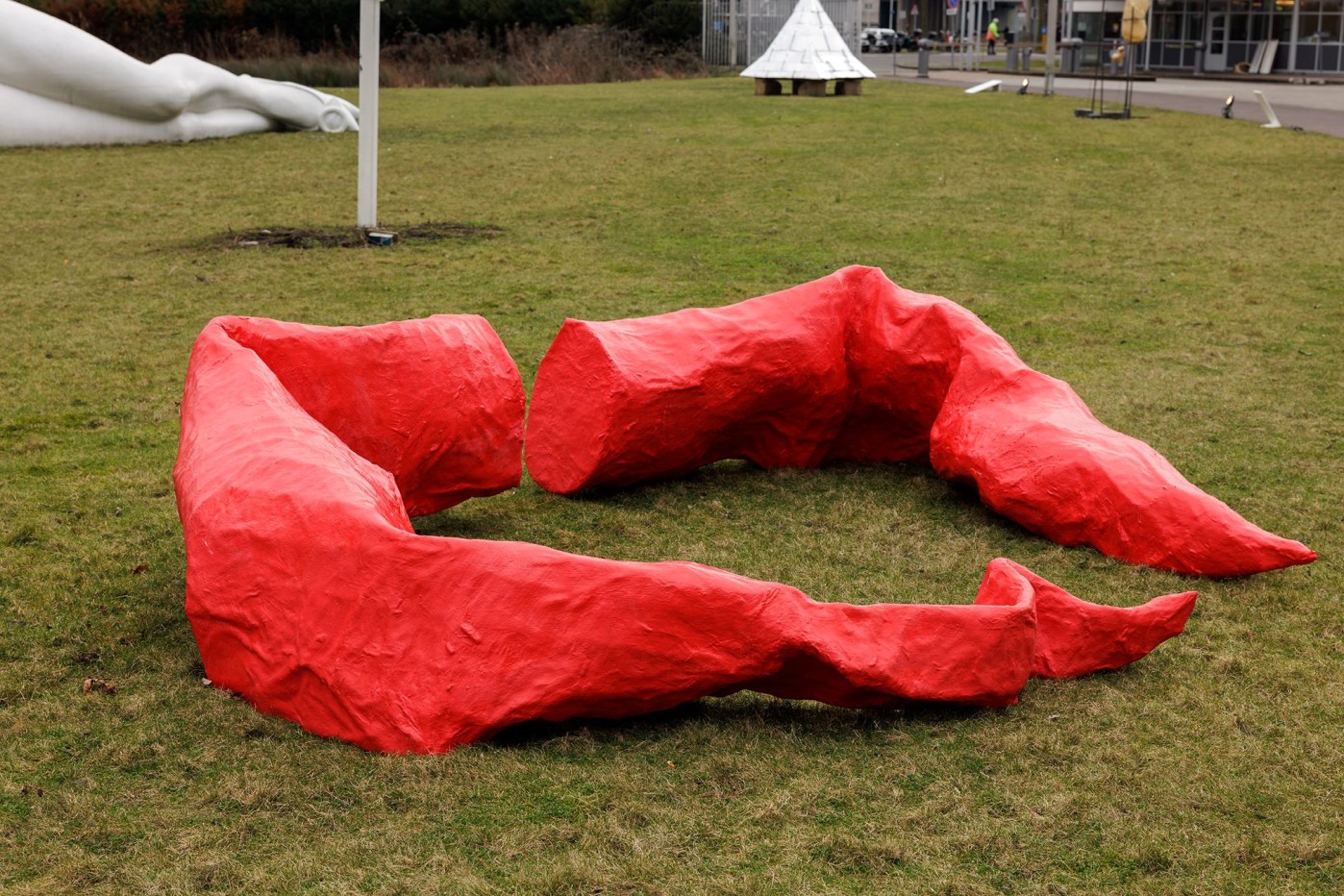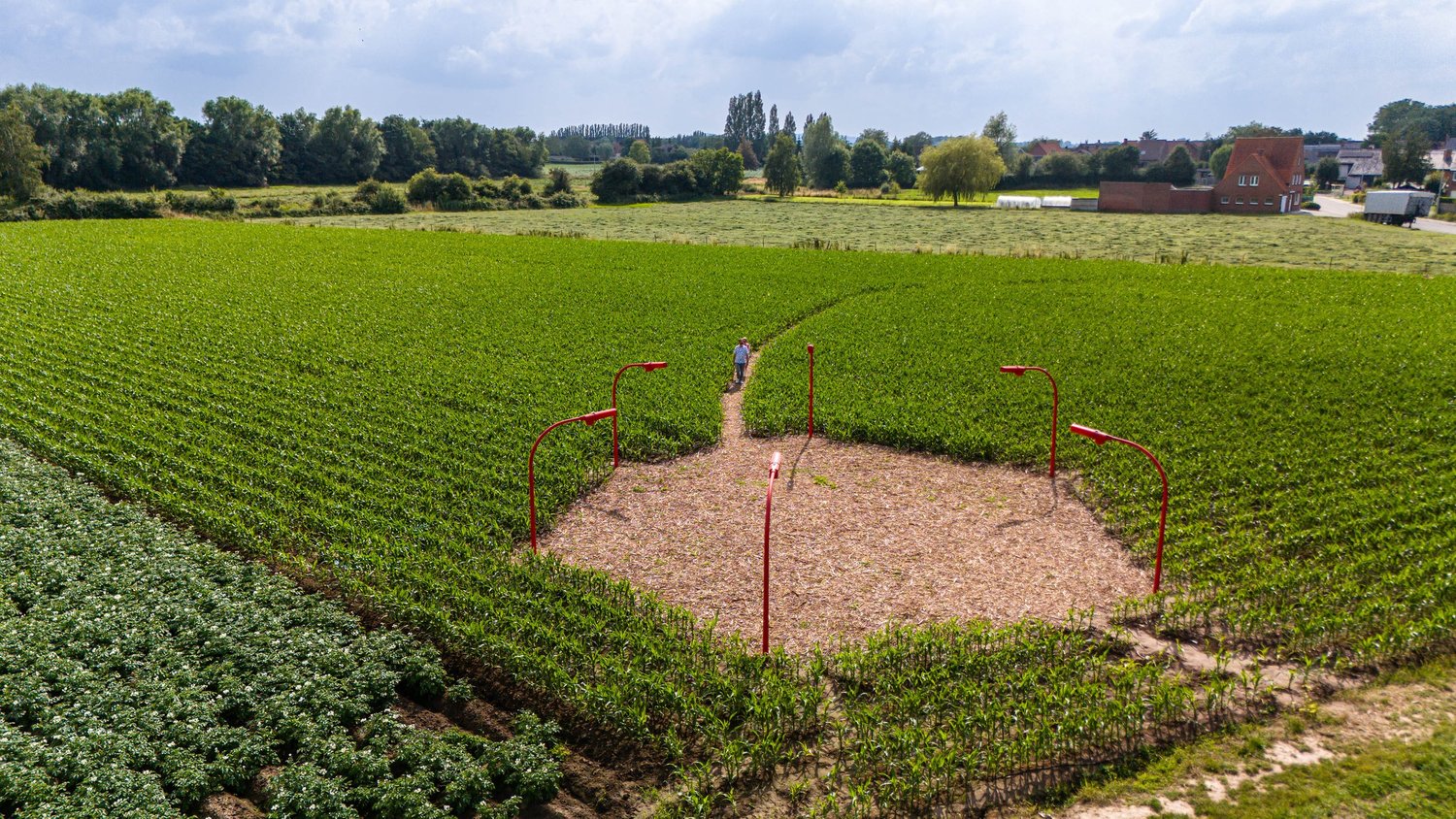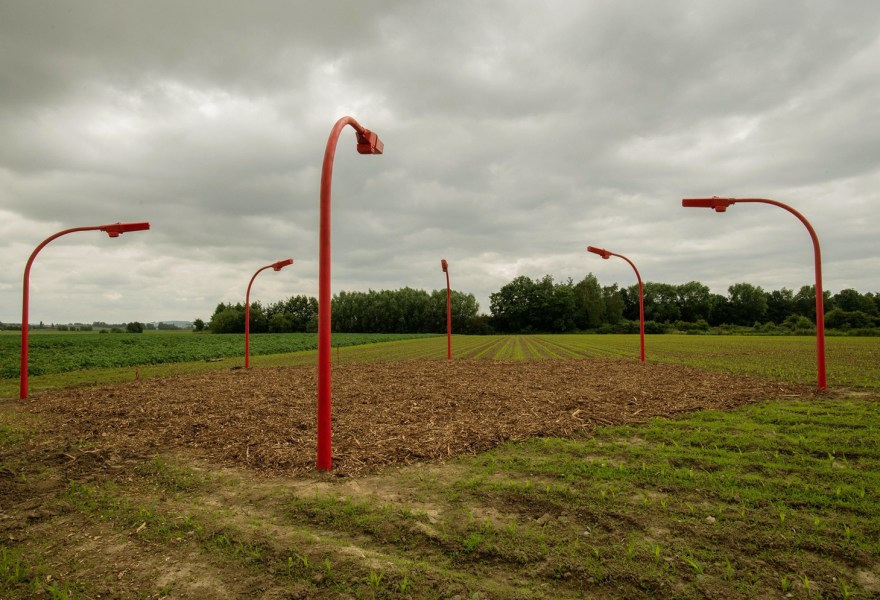30 july 2024, Yves Joris
Curved witnesses, mourning and reflection at the Watou Arts Festival
The sun is still finding its way. Over France, it has already won the battle against the clouds, but here in Watou, the skies remain grey. In the serene vastness of the Flemish landscape, amidst lush fields and under a sky still heavy with clouds, stands an intriguing artwork by Sanne van Balen. The six curved red structures rising from the earth resemble lampposts, but there is something about their form that goes deeper than their everyday appearance. The work, entitled Tell Me (2024), is part of the Watou Arts Festival and evokes a reflection on the human condition, mourning and the search for meaning.
Sanne van Balen (°1994) is a contemporary Dutch artist known for her narrative and often poetic installations. She has a background in both Dutch literature and the visual arts. In her work, she explores themes such as human vulnerability, memory and the relationship between humans and nature. Her installations, often characterised by strong visual language and symbolism, invite introspection and profound reflection. Her artworks have been displayed at various exhibitions and art festivals and her work can now be admired in Watou. With Tell Me, she shows the visitors of the arts festival her ability to weave emotion and philosophy into powerful images that resonate with universal human experiences.
Thinking of Käthe Kollwitz
Does the environment evoke a certain association in my mind? The curved forms of Sanne's red structures evoke memories of The Mourning Parents, the heartbreaking sculpture by Käthe Kollwitz, located at the cemetery in nearby Vladslo. Kollwitz sculpted this monument in memory of her son Peter, who fell in World War I. The pain and loss expressed in this work are also found in the silent, almost melancholic postures of Van Balen's red lampposts. Like Kollwitz's mourning parents, they bend towards the earth, as if bearing the weight of an unspoken sorrow. This installation also seeks to communicate with the nature around it. The bright red colour contrasts sharply with the natural tones of the landscape, evoking a sense of alienation. It's as if they have detached themselves from their urban context and now stand as silent guardians over the field, thus forming a paradox of presence and absence, while also making us aware, through their red colour, that they are outliers in this predominantly green environment.

Sanne van Balen, Lantern, 2024, Josilda da Conceição
Language has no fixed form
The exhibition catalogue of the Watou Arts Festiva, Van Balen comments that "language has no fixed form but needs a carrier or body." And this becomes completely clear through this installation. In Tell Me, she captures the essence of human vulnerability and transience. The curved postures can be seen as a physical representation of introspection and mourning, but also as an invitation to reflect on our place in the world and how we deal with loss and memory. The lampposts, without casting their light, point to a silence and calm that is necessary for deep contemplation.
Tell Me calls for a dialogue with the viewer, not only about its aesthetic value, but also the emotional and philosophical dimensions of existence. The artwork functions as a bridge between the past and present, reminding us of the tragedies of the past as depicted by Kollwitz, while urging us to think about our current reality and how we connect with our environment and history.
The placement of these poles in an open field suggests a search for enlightenment or insight that is not directly accessible. They stand as symbols of lost light, a metaphor for those moments in life when clarity and understanding elude us. The arrangement ensures that only a small area is illuminated, an exclusive space that is perhaps not accessible to everyone. The choice of red for the poles enhances the contrast between art and nature. Red, a colour often associated with passion, danger and life, evokes strong emotions. It is also not a natural colour for such poles. In this context, the red can be seen as a sign of the vibrancy of human emotions, even amidst a quiet and somewhat desolate environment.

Sanne van Balen, Stem, 2024, Josilda da Conceição. Prospects Mondriaan Fonds, Art Rotterdam
Exegi monumentum
In the same catalogue, I also read that, to Sanne, "the landscape is a linguistic place that both holds and conveys meanings from the environment". The forms and placement of the lampposts can therefore also be interpreted as a conversation with the earth itself. They are like living beings bowing to listen to the stories of the land, to absorb the history and secrets hidden beneath the surface. This gesture of listening and bowing connects the human experience of loss and mourning with the natural world, where cycles of life and death, growth and decay, continue eternally.
But the conversation is also effectively conducted. For this installation, together with a poet, she engaged in dialogue with residents of the border village. The soundscape of ZONDERWERK, pseudonym of Dijf Sanders and Linde Carrijn, brings a composition of these voices combined with the poem by Marjolijn Van Heemstra. You listen to the words scattered above your head. "There is history in our name. Lantern comes from the Greeks – torch, fire basket, derived from the word lampein – and means to shine, to radiate. And the pole originates from the Roman palus.”
Tell Me by Sanne van Balen is a powerful symbol of human emotion, a monument to both mourning and resilience, and an invitation to pause and reflect on the depths of the human heart. In these silent red lampposts, bent and unlit, we find an echo of our own questions and sorrows and perhaps, like with Kollwitz, a moment of shared human experience and understanding.
Sanne van Balen is represented by the Amsterdam gallery Josilda de Conceição. The installation Tell Me is also available to those who can't get enough of it. You may have to wait until the end of the arts festival to take the work home and definitely need to have enough space because, with dimensions of 3 x 3 x 14 metres, it is not an artwork that fits in the average garden.

Sanne van Balen, Zeg me, 2024, Josilda da Conceição. © Marijn Depoorter
